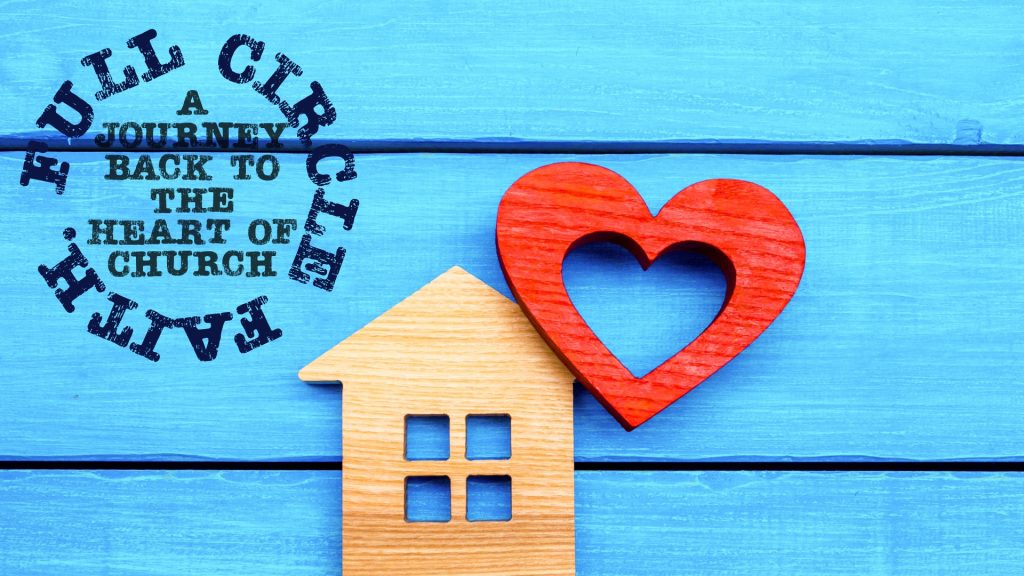Full Circle Faith: A Journey Back to the Heart of Church in Acts 2

The Early Days of Liberty
Late December 2000, I was 18 years old, and still at college when I came across a church plant called Rialto Community Church. I went along one Sunday and quickly found myself immersed in the life of the church. I was invited to smaller meeting in a nearby home and vividly remember feeling connected to this group of people and their mission to plant a church in Rialto. We’d met every Thursday night for “Intercession” in a small flat in Fatima Mansions, that was soon to be demolished. About twenty of us—all that the church counted at the time—huddled close, shoulder to shoulder, filling the tiny space, our prayers, and songs, raw and real and passionate. Those days were filled with ministry outside usual church hours, running kid’s and youth clubs in Dolphin’s Barn and reaching out to those in need in as many ways as you can imagine. That experience of a close-knit family of faith on mission together marked a profound chapter in my life. Witnessing the church’s tangible love and compassion first-hand spoiled me for settling for anything less.
The Acts 2 Church
I probably couldn’t have explained it at the time but what I was experiencing was the kind of church we see described in Acts chapter 2. It’s the first description we have of the church in scripture. Straight after the transformative event of Pentecost where the believers were filled with the Holy Spirit, and Peter’s Spirit-inspired words reached the hearts of around 3000 people. We have this description of early church life that has moved me deeply for the past 20 years of serving as a church leader. The potential that exists within a Spirit-led, united, and active church community is so compelling to me and is what I experienced in Rialto in those early days.
Verse 42 onwards describes the commitment of this first church: devoted to the Apostles’ teaching, to fellowship, to breaking bread, and to prayers. This new community was wrapped in awe, as the Apostles performed signs and wonders. They loved each other deeply, shared everything, selling possessions to meet needs, each day together at the temple and at home, breaking bread with joy, praising God. And, as promised, the Lord continued to enlarge their family daily with those who came to know Jesus.
The authenticity of that community, was what made Rialto Church, now called Liberty Church, irresistible to me. It’s a way of life that’s characterised us since the beginning—built on the very essence of the church that Jesus has purposed.
Growing Pains
The church in Rialto grew and our gatherings expanded to a more considerable congregation in Ardee Street. There were great things happening but this shift also revealed a troubling reality; even though we grew to maybe 150 members, the actual ministry outside of the walls of the church continued to involve just a committed few. We were inadvertently drifting away from being a church with everyone involved in a communal mission, and towards a Sunday-centric church centred on a building. It troubled me to think that new people coming to faith at Liberty may not have the same kind of experience that I’d had in the early days. That it may be possible for them to settle for a Sunday-centric, service attending, kind of faith rather than real engagement in the purposes of God alongside the people of God.
As a young leader I sensed this gap, though was likely not able to articulate it or recognise it in full back then. In time we planted out into Clondalkin and Bray and Finglas in the hope of recreating what we had in Rialto. Again, great things happened and new churches grew but to me it always felt like they stopped short of recreating that compelling example of Acts 2 or those early days of Rialto. In the congregation I pastored in Bray I would preach and speak about our biblical convictions on love, witness, and the missional implications of being filled with the Spirit of God, but never managed to cultivate that kind of on-mission-together mindset or environment. There was a disconnect between preaching and practice that needed to be addressed for the sake of our people and the call of God on their lives. It felt like an outside observer could tell what we believed by what I said on a Sunday morning, but not necessarily by observing our life together. It’s easy to say “love one another” but difficult to obey in an individualistic, consumerist world.
Rediscovering What Matters
I’d been Pastoring the church in Bray for about 7 years when I came across a book called Letters to the Church by Francis Chan. His depiction of the church’s potential as described in the Bible, and what I’d describe as his Holy dissatisfaction with settling for less, came across to me like he had been reading my mind (or listening to my sermons). He told the story of leaving his mega-church behind to immerse himself and others in a way of living as the church that Jesus envisioned; small churches that would meet in homes and practice the ways of Jesus together. The focus on larger and larger church gatherings had created a set of conditions that made it less likely for people to live as the church in the way’s that Jesus intended.
I got to go on a trip to San Francisco in 2019 to see what was happening first-hand. I was immersed in the life of their church for a week. It reminded me of my first week in Rialto. When I got back people would ask me about my trip and what I had experienced, and I found myself repeatedly using the word “beautiful”. I’d tell anyone who’d listen about the kind of simple gatherings I had witnessed: Of gatherings where everyone used their gifts on behalf of the others present. Of ordinary people immersed in scripture together day after day and helping one another to apply it to their lives. Of early morning prayer meetings. Of bi-vocational Pastors leading churches in their homes. Of Elders who regularly got on their knees together on behalf of the church. Of regular outreaches of every-day church members looking for opportunities to share the love of God with their neighbours. It was Acts 2, It was the church, the bride of Christ. It was beautiful.
It reminded me of the early days of Rialto. What the guys in San Francisco had managed to do was figure out how to multiply that into other communities, beyond one leader or a centralised congregation. It felt like God was leading us full circle, reminding us of who we were as a church and equipping us to recreate that beauty in the places where we live. That the same kind of dynamic that existed in Rialto might exist in Bray, Clondalkin, Lucan, Ballyfermot, Tallaght, Drimnagh and on and on.
Back to Basics
After my San Francisco trip Noel and I got together to think through the future of the church. We decided to meet early morning for a couple of weeks to be able to prioritise that work apart from the business of day-to-day life and ministry. The Lord met us in those early mornings and the work got abandoned in favour of prayer and worship. He knew what he was doing, and we found ourselves continually recognising and confessing that the church belongs to Jesus and that we were willing to do or be whatever he commanded.
When the pandemic struck in 2020, we found ourselves forcibly removed from the existing rhythms of everyday life and church ministry and afforded the space to reimagine what church might look like in the future, guided by what we could discern as Jesus’s desire from scripture. A group of us met on Zoom weekly to pray and read and discuss where God might be leading us. This led to the planting of several Home Churches late 2022: Smaller gatherings shaped as spaces that facilitate obedience to God’s plans for His people, His church.
Full Circle: Home Churches in Multiple Communities
In recent weeks I’ve visited some of these Home Churches. And it is so encouraging to say that if you were to ask me to describe to you a picture of the “beautiful”, Acts 2 church I don’t need to tell you a story of San Francisco 5 years ago, of Rialto 20 years ago, or even of Jerusalem 2000 years ago. I could tell you what happened this week in Tallaght, or Lucan, or in any of the places where we have planted Home Churches.
Week after week there are Churches meeting in homes all over Dublin committed to loving one another as Jesus has loved them. Close-knit families of faith who intentionally overlap their lives in ways that you don’t find outside of Jesus’ church. You’ll find people devoted to the word of God, praying and breaking bread together in ways that expose them to the love of God and shape their lives. You’ll find them enjoying each other’s company, walking through the ups and downs of life together, using their gifts to build each other up and forgiving one another when they mess up. You’ll find them figuring out how to reach out in love to meet the practical needs of their communities, living as salt and light. You’ll find them sharing their faith with their neighbours, families and work colleagues and the Lord adding to them people who are being saved, who in turn are immersed in this same kind of community. We are witnessing a move of God in Dublin.


